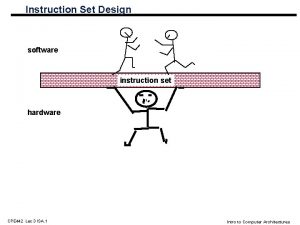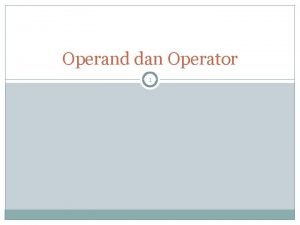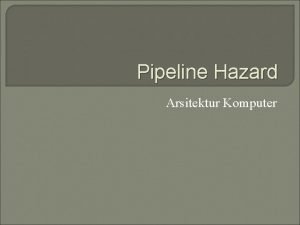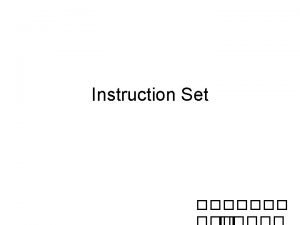32 Computers that use Zero operand instruction for





- Slides: 5

32 Computers that use Zero operand instruction for arithmetic operations also use one operand PUSH and POP instruction to copy value between memory and the stack. PUSH source; Push the value of the memory operand onto the Top of the stack. POP destination; POP value from the Top of the stack and copy it into the memory operand. EX: A=B+C PUSH B PUSH C ADD; POP A EX: Y=(X+D)* (N+1) Pop the two value of the stack, add them, and then push the sum back into the stack PUSH X PUSH D ADD PUSH N PUSH 1 ADD MUL POP Y

33 Assembly Language Instruction Assembly language instructions are provided to describe each of the basic operations that can be performed by a microprocessor. They are written using alphanumeric symbols instead of the 0 s and 1 s of the microprocessor's machine code. Program written in assembly language are called source code. An assembly language description of this instruction is ADD AX, BX In tins example, the contents of BX and AX are added together and their sum is put in AX. Therefore, BX is considered to be the source operand AX the destination operand. Here is another example of an assembly language statement: LOOP: MOV AX, BX ; COPY BX INTO AX This instruction statement starts with the word LOOP. It is an address identifier for the instruction MOV AX, BX. This type of identifier is called a label or tag. The instruction is followed by "COPY BX INTO AX. " This part of the statement is called a comment. Thus a general format for writing and assembly language statement is: LABEL: INSTRUCTION ; COMMENT

34 The 8086 Addressing Mode When the 8086 executes an instruction, it performs the specified function on data. Thee data are called its operands and may be part of the instruction reside in one of the internal registers of the 8086, stored at an address in memory, or held at an I/O port. To access these different types of operands, the 8086 is provided with various addressing modes: 1. Register Addressing Mode With the register addressing mode, the operand to be accessed is specified as residing in an internal register of the 8086, an example of an instruction that uses this addressing mode is MOV AX, BX This stands for move the contents of BX, the source operand, to AX, the destination operand. Both the source and destination operands have been specified as the content of the internal registers of the 8086. See Figure 10(a, b). 2. Immediate Addressing Mode If a source operand is part of the instruction instead of the contents of a register or memory location, it represents what is called an immediate operand is accessed using the immediate addressing mode. Typically, immediate operands represent constant data. Immediate operands can be either a byte or word of data. In the instruction MOV AL, 015 H The source operand 15 H is an example of a byte-wide immediate source operand. Note that the value of the immediate operand must always be preceded by a zero. See Figure 11(a, b).

35 Address Memor y Conten t 8086 MPU 0000 IP 0100 CS 0100 MOV AX, BX 0 DS 0100 XXXX . 8 B Instruction S 1 S 0100 2 ABCD C 3 . XX Next Instruction E S A X B Figure 10(a): Register addressing mode before execution. X 8086 MPU 0002 IP 0100 CS DS C X SS Address Memory Content 01000 01001 . 8 B C 3 01002. XX Instruction MOV AX, BX Next Instruction ES ABCD AX D ABCD BX X CX S DX P SP BP SI B DI P Figure 10(b): Register addressing mode after execution. S I D

36 Address Memor y Conten t 8086 MPU 0000 IP 0100 CS DS S XX 01000 . B 0 01001 15 01002 . XX 01003 XX Instruction MOV AL, 015 H Next Instruction S E S A X Figure 11(a): Immediate addressing mode before execution. B X 8086 MPU 0002 IP 0100 CS DS SS C X Address Memory Content Instruction 01000 01001 . B 0 15 MOV AL, 015 H 01002. XX 01003 Next Instruction ES 15 AX D BX X CX S DX P SP BP SI B DI P Figure 11(b): Immediate addressing mode after execution. S I D









